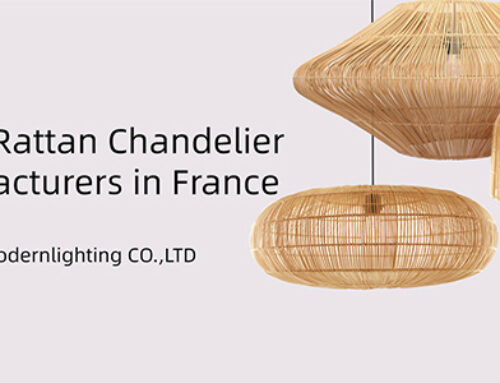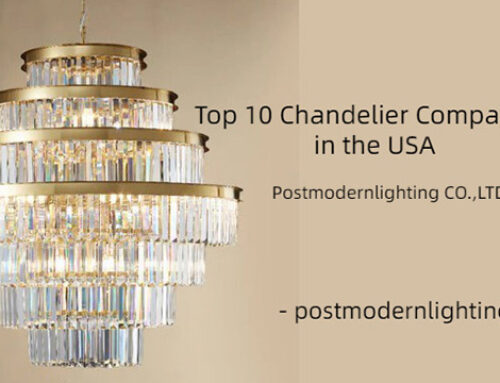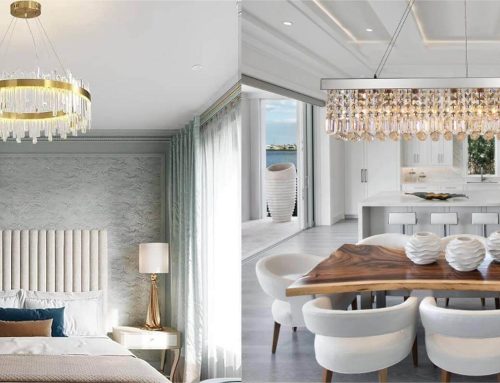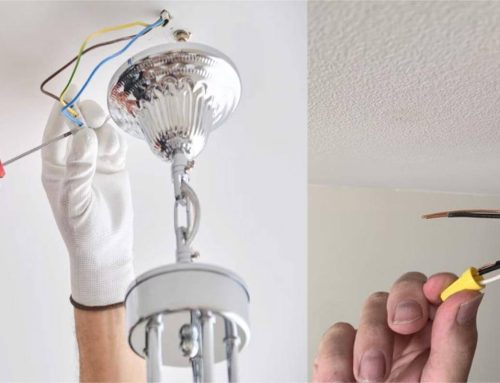If you are in the market for a dazzling chandelier to add elegance and charm to your home, it is vital to understand the quality of the crystal. Crystal chandeliers have long been revered for their timeless beauty and captivating glow, but not all crystals are created equal. In this comprehensive guide, we will explore the various aspects of crystal quality that every chandelier buyer should be aware of. From crystal types to quality levels, this article will help you make an informed and satisfied purchase decision.
1. Chandelier crystal basics
Crystal chandeliers have a long history and continue to be sought after for their opulence and charm. They can reflect light in attractive patterns, creating a charming atmosphere for any room. When carefully selected, chandeliers can be the centerpiece of an interior design, enhancing the overall beauty and atmosphere.
All crystal is made of glass. However, the glass used to make chandelier crystal is very different from the glass used for windows, drinking glasses, glasses, etc. Crystal contains lead oxide, which makes it heavier and has a higher refractive index than ordinary glass. This means the crystal is brighter, more sparkly, and prismatic.
The lead oxide content in chandelier crystal is important, but it’s also safe for consumers’ health. The rule is that the more lead oxide in the crystal, the better it reflects light, so the higher the lead oxide content, the better. Lead oxide content is divided into three major categories:
1) The first category
Crystal glass is glass containing 6% to 10% lead oxide, but U.S. standards allow transparent glass with any amount of lead oxide to be called crystal.
2) The second category
Half lead refers to 24% to 30% lead oxide.
3) The third category
Full lead crystals refer to crystals containing more than 30% lead oxide.
In addition, there are three basic methods of making chandelier crystal:
- machine cutting
- hand cutting
- hand blowing
4) Machine cutting
Crystals that are machine-cut produce sharp facets, a precise polish, and a high level of visual purity.
5) Hand cutting
Hand-cutCrystal is sometimes made using the traditional method of cutting with an iron and a sandstone wheel and then polishing it on a wooden wheel filled with marble powder. But hand-cut crystal is also made using more modern methods. There are many types of hand-cut crystal, including Czech crystal, Heritage crystal, Regal crystal, Crystalique crystal, and Turkish crystal.
6) Hand blowing
Venetian and Murano crystal is hand-blown by artisans rather than cut, so the crystal has smooth, rounded edges. The mouth-blown craft creates a unique, heirloom-quality piece of art.
(Another related post: Crystal Chandelier VS. Glass Chandelier: What is the Difference?)
2. Understand the crystal type of crystal chandelier
Here are three of the more common crystal types:
1) Swarovski Crystal
Swarovski crystals are known for their exceptional brightness and clarity. They are produced by Swarovski, an Austrian company known for its precision-cut crystals, and are considered the gold standard in the crystal industry. Swarovski crystals are crafted with a proprietary formula that ensures maximum flicker and light refraction. If you are looking for unrivaled quality and are willing to invest in top chandeliers, Swarovski crystal is the perfect choice for you.
2) Asfo Crystal
Asfo Crystal from Egypt is another great choice for chandelier lovers. These crystals are made with a lead content that enhances their shine and brightness. Asfour crystals are known for their affordability without compromising quality. If you are looking for a fine chandelier on a modest budget, Asfour Crystal may be the ideal choice.
3) Egyptian and European crystals
Egyptian and European crystals are widely used in the production of chandeliers, achieving a good balance between quality and price. Although they may not be able to match the brilliance of Swarovski crystals, they still show a charming shimmer that can enhance the ambiance of your living space.
4) K5 or K9 borosilicate glass (“Chinese crystal”)
This is the most common type of “crystal” you’ll see out there. If the light fixture itself was made in China, the crystal is most likely of this type. Strictly speaking, borosilicate glass is not crystalline because its lead content is less than 10% (the original names “K5″ and K9” refer to the percentage of lead oxide content, which are 5% and 9% respectively). K9 glass It should be considered to be of higher quality than K5 glass.
K9 glass is popular for a number of reasons: it is relatively cheap to manufacture compared to real crystal; it has a relatively high refractive index and fairly good transparency properties. This type of glass can be highly polished like crystal. Additionally, since most of the world’s mass-produced lighting is mass-produced in China, it makes sense that these fixtures would come with K9 glass – a cheaper option that’s made locally. If you want to buy
A crystal chandelier or pendant can cost less than $1,500, and the crystal will most likely be K5 or K9 borosilicate glass. Think of the K9 as the Toyota Camry of chandelier glass: relatively cheap, reliable, ubiquitous – it gets the job done. However, considering your chandelier is the jewel in your home, you may want to consider spending a little more and getting something more Something exquisite – something of heirloom quality that you’ll want to pass down from generation to generation. You may want to choose real jewelry rather than costume jewelry.
(Another related post: 10 Best Crystal Chandeliers of 2023)
5) Gem cut crystal
Gem-cut crystal generally refers to high-quality, “real” crystal with a lead oxide content between 24% and 34%. Within this category, there are grades of quality points such as optical purity and polish. Optical purity is related to minimizing the distortion of the light that passes through it, and the best way to do this is to control the cooling process of the molten crystal.
Once the molten crystals are poured, it cools like a cake fresh out of the oven: the outer parts cool first, the innermost center last. For crystals, these temperature changes can cause tiny striations—sort of like fingerprints in the middle of the crystal. To prevent this from happening, manufacturers learned they could apply heat during the cooling process so that the outside of the crystal cooled at about the same rate as the core. Obviously, this can be a bit tricky and adds to the cost of manufacturing the crystal. quality
Other changes include the clarity of the facets and how polished the crystal surface is. Some manufacturers add a semi-precious metal coating that protects the crystal’s luster.
6) Murano glass
Murano glass is often mentioned in the same sentence as some of the world’s most exquisite chandeliers, but Murano glass isn’t technically crystal, which can be confusing. It is made from blown glass from the Italian island of Murano, which borders Venice. Over the centuries, Murano’s master craftsmen developed many of the glassblowing techniques that are still used today. Technically, only glass blown on the tiny island of Murano can be called Murano glass, although you wouldn’t know that from the widespread misuse of the term by unscrupulous marketers. It represents a very traditional chandelier style.
7) Baccarat crystal
Like Waterford, Baccarat makes its own chandeliers from its own handmade crystal. While they do have some modern designs, most of their products are quite traditional. Baccarat handcrafts crystal through a detailed, time-consuming process that has changed little over the past several hundred years. Baccarat is synonymous with expert craftsmanship. How many times does each crystal need to be inspected to ensure it is defect-free? If Swarovski is the Ferrari of crystal, then Baccarat is the McLaren.
8) Rock crystal
Rock-cut crystal is natural clear quartz mined from the earth. Crystal is not optically pure, nor would you want it to be. It’s full of veins and has a natural bite, all of which make it even more interesting. The crystal itself is often thick and large and is often paired with a very traditional chandelier – true to the time and place where the crystal was first mined: the Bohemian region of eighteenth-century Central Europe.
This is an expensive but potentially very interesting addition to a chandelier. If you use crystal, make sure your fixture design doesn’t compete with the interesting nature of the crystal. Crystal should be the star of the show and should not be paired with busy, over-designed light fixtures.

(Another related post: How to Choose the Right Bulb for Chandeliers?)
3. Crystal quality grade of crystal chandelier
Crystal quality is usually graded according to several factors, including cut, clarity, color, and overall craftsmanship. Here are the common quality levels you should be aware of:
1) Super Class
High-quality crystals, such as Swarovski crystals, are made with great attention to detail. They have a perfect cut, excellent clarity, and a stunning shine. If you crave perfection and are willing to invest in luxury chandeliers, choose quality crystals. I have thought that I have a friend who is a wholesaler of hard wax beans. His business has been very good in recent years and he has made a lot of money. Therefore, when he decorated his new house, he bought a Swarovski crystal chandelier. I was fortunate enough to visit his home and the effect was indeed very shocking.
2) Standard grade
Standard-grade crystals strike a balance between quality and economy. While they may not have the same brightness as quality crystals, they still have an impressive glow, making them an excellent choice for those looking for elegance and budget awareness.
3) Economy level
Economy-grade crystals are the most affordable option. While they may have slight imperfections and reduced gloss, they can still add a touch of charm to your space without spending too much money.

(Another related post: How to Clean a Chandelier?)
4. Choose the right crystal chandelier
When choosing a crystal chandelier, please consider the following factors:
- Style and design: Choose a chandelier that complements the interior style of your home, whether it’s traditional, modern, or eclectic.
- Size and proportion: Make sure the chandelier is sized appropriately for the intended space to create a balanced and harmonious look.
- Lighting needs: Consider the brightness of the chandelier and the amount of light it provides to ensure it meets your lighting requirements.
- Installation and maintenance: Choose a chandelier that is easy to install and maintain to extend its service life and keep it in its original condition.
- Certification: Check industry standard certifications to guarantee the authenticity and quality of the crystals used.
1) What to look for when buying crystals
Most people should be able to recognize acrylic right away: If you’re looking at a $50 “crystal” chandelier at Home Depot, the crystals are almost certainly plastic. Acrylic is very light, and has a dull surface, poor transparency, and unclear facets. Apparently, glass is an upgrade from clear acrylic, but doesn’t have the refractive properties of crystal.
It’s just, well, glass. Because this is a cheap solution, the glass “crystals” are often poorly made, the facets are not sharp enough, the polish is poor, and you will often see air bubbles in them. If you’re reading this, you care enough about quality to avoid both of these options like the plague.
#1. Make sure it’s crystal, not acrylic or glass
Crystal is a type of glass that is essentially made in the same way – by heating the ingredients to a molten state. The molten mixture is then poured into molds to give the chandelier crystal its shape. Each crystal’s facets are carefully designed because thoughtful design will produce greater light refraction.
If left alone, the lead crystal will cool like a cake: the outside cools quickly, while the core takes longer to dissipate heat. This temperature difference means that the inside of the crystal cools later than the outside, which leaves very fine streaks in the crystal. You might not notice them at first glance—you might even mistake them for fingerprints. But these tiny stripes distort the light that passes through the crystal. Once you notice them, it’s hard to ignore them. Cheaper crystals are made without any control over the cooling process and can therefore show these subtle distortions.
#2. Bubbles in the crystal
Another thing to watch out for is air bubbles. Cheaper crystals often have one or two tiny air bubbles inside. Once you see a bubble, you can’t see it again. Crystal is rarely branded, and there is often no information about the source of the crystal on the chandelier you are purchasing. If you’re buying a particular chandelier, you’re probably buying it because you like its design, and you’ll have to take the crystal as soon as you receive it, regardless of the quality.
(Another related post: How to Install a Chandelier?)
5. Conclusion
Investing in high-quality crystal chandeliers can make a transformative addition to your home decor. With a variety of crystal types and quality levels to choose from, there is always the perfect chandelier to suit every taste and budget. When making your choice, remember to consider your style preferences, space requirements, and the desired level of brightness. Carefully selected crystal chandeliers will not only brighten up your space but also take it to new heights of elegance and sophistication.






Leave A Comment